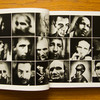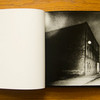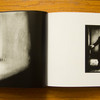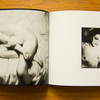Review: Half Life by Michael Ackerman

There’s something unrelenting in Michael Ackerman’s photographic world - something that the artist himself has been coyly denying in the few interviews I’ve read. That’s fine. It’s usually a mistake to listen too carefully to what artists have to say - the public persona is as much part of what they do as their images1. So let’s stick with the photographs, in particular with Half Life.
The book shows us a stark world, black and white (often just literally black and white, without any shades of gray in between), grainy, with high contrast, occasionally blurry or out of focus. It is not without tenderness, though. But it’s a stark tenderness: The photograph embossed on the cover shows a self portrait, the photographer holding his partner’s head very close, his gaze averted from his own camera lens, hers, however, reacting to the camera and its conventions. The artist’s shaven head dominates the composition, the seeming violence in his gesture is counterbalanced by the woman’s eyes, the way she lets the viewer know that she is aware of the game that is being played here.
Photography is a game, after all - something people love to ignore. It’s a game where the rules aren’t always that clear, which is, confusingly, part of what makes it so exciting. It’s a game that often is little more than an invitation to come and play and try to figure out the rules as one goes. This would certainly be the Half Life game, and that’s why asking artists about what they do is often such a bad idea: Why or how would being given the rules be fun?
Maybe approaching artists like Ackerman as the organizers of such a game is a better idea than asking them about their photographs, asking them why they look a certain way, asking them what this all means. On the one hand, what point would there be in making art when you’d have to explain it once you’re releasing it into the world? On the other hand, art too often is associated with something that is daunting, something requiring a certain decorum when in fact most great art doesn’t need any of that stuff. Children play, often by inventing their own games, happily changing the rules. Adults don’t do that any longer. Maybe art can help us get back to some of the skills we had to lose. So here then is Half Life, the die is cast.
Half Life, photography by Michael Ackerman, essay by Denis Kambouchner, 168 pages, Dewi Lewis Publishing, 2011
1 Of course, a savvy artist will use this mechanism to great effect: The public has a craving for artists to talk about their work and about themselves.







